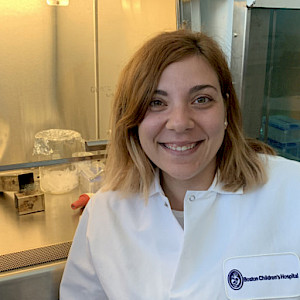
Angelica D'Amore, PhD
Dr. D'Amore's research focuses on animal modeling, using CRISPR-Cas9 technology to generate disease models in zebrafish, and animal husbandry/maintenance for our TSC2 mouse-colonies. Her work is also based on in-vitro experiments, focusing on neuronal-dissociation from rodents.
Related Publications
- Generation and characterization of six human induced pluripotent stem cell lines (iPSC) from three families with AP4B1-associated hereditary spastic paraplegia (SPG47)
- Loss of ap4s1 in zebrafish leads to neurodevelopmental defects resembling spastic paraplegia 52
- High-throughput imaging of ATG9A distribution as a diagnostic functional assay for adaptor protein complex 4-associated hereditary spastic paraplegia
- Systematic Analysis of Brain MRI Findings in Adaptor Protein Complex 4-Associated Hereditary Spastic Paraplegia
- Defining the clinical, molecular and imaging spectrum of adaptor protein complex 4-associated hereditary spastic paraplegia
- Adaptor protein complex 4 deficiency: a paradigm of childhood-onset hereditary spastic paraplegia caused by defective protein trafficking
- Generation and Characterization of Six Human Induced Pluripotent Stem Cell Lines (iPSC) From Three Families with AP4M1-associated Hereditary Spastic Paraplegia (SPG50)
- High-throughput Imaging of ATG9A Distribution in Fibroblasts as a Diagnostic Functional Assay for Adaptor Protein Complex 4 - Associated Hereditary Spastic Paraplegia
- Seizure reduction in TSC2-mutant mouse model by an mTOR catalytic inhibitor
- AKT-mediated phosphorylation of TSC2 controls stimulus- and tissue-specific mTORC1 signaling and organ growth
- Phenotypic rescue via mTOR inhibition in neuron-specific Pten knockout mice reveals AKT and mTORC1-site specific changes